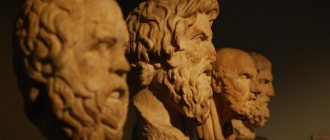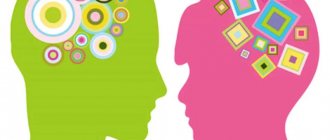Identification and self-identification
The concepts of identity and identification are especially important to distinguish when studying intergroup relations. They are close in meaning, but differ significantly as scientific terms. Identification in a general sense is the likening of something to something. In the humanities and social sciences, in particular in psychology, various types of identification are distinguished. For example, it is often defined as establishing the identity of an unknown material object with an already known object based on the coincidence of certain significant features. There is also such a thing as personal identification, or self-identification. This is the individual’s established attitude towards himself.
Sigmund Freud, the founder of psychoanalysis, first introduced the concept of identification. However, it is in social psychology that it has become most widespread. Freud originally viewed identification as an unconscious process of imitation. He believed that this is one of the ways to psychologically protect the individual. In social psychology, it is believed that identification is an important condition for socialization, the assimilation by a person (primarily this applies to children) of patterns and patterns of behavior in society. As a result of socialization, the individual accepts his social roles. He realizes that he belongs to a certain group (age, professional, religious, political, racial, ethnic), whose norms must be followed.
What is identification: definitions
What is this? Identification is in psychology the process of an individual’s imitation of another subject, group, fictional character (image); the process of self-identification of an individual with a group, image, or another person. Identification is, in simple words, the search for an answer to the question “Am I the same as who?”
The term was introduced by S. Freud. The psychologist examined the phenomenon within the framework of psychoanalysis. The first thing Freud studied was the child’s identification with one of the parents. At the same time, the researcher came to the conclusion that identification is always based on fear and anxiety. By identifying with a stronger, more authoritative person, the individual reduces the discomfort he experiences.
However, a little later the author identified several types of identification:
- primary (child with mother);
- identification with a loved one (“I want to be like you”);
- identification with an unloved person (a defense mechanism of the psyche, “you will not offend someone like yourself”);
- identification in the perception of community (“stand in my place”, “what would he do”, “what would he think”).
Over time, the concept began to be used in a broader sense. According to him, personal identification is imitation, emotional fusion with someone. However, some psychologists still adhere to the psychoanalytic theory, arguing that it is a defense mechanism developed by evolution that helps in adaptation. Let's take a closer look at modern definitions and find out what identification means in psychology.
The meaning of the word "identification"
The name is derived from the Latin indentifico, which means “to identify.” Identification is the establishment of correspondence, similarity between two or more objects.
Identification concept
According to definitions from various dictionaries, identification is:
- identification, recognition of objects (encyclopedic dictionary);
- comparison with a standard, identification for litigation (business dictionary);
- subconscious identification of oneself with another person, often a parent (psychiatric dictionary);
- a psychological defense mechanism in which an individual becomes like his offender and identifies himself with him (psychological dictionary);
- a protective mechanism of the psyche, in which a weak person adopts the experience and features of a strong person (psychological dictionary).
In sociology, identification is understood as the process of an individual identifying himself with some group, another person. This is clearly visible in the example of youth subcultures. An individual copies the external attributes, behavior, values, beliefs, and interests of the group.
Concept of identity
Identification in modern terminology is a phenomenon that we observe as if from the outside. In this case, we can state the presence of a certain process and determine its result. There is also such a thing as identity. It refers to the state of an individual's inner world. This is a subjective attribution of oneself to a certain social group (class, type, species). So, identity in its most general form is the identification of a person with others.
Henry Tajfel's Personality System
Henry Tajfel, an English psychologist, is the creator of social identity theory. He made significant contributions to the study of the psychology of relations between groups. In accordance with the theory of Henry Tajfel, one can imagine the “I-concept” of an individual as a system that regulates all kinds of forms of social behavior. This system includes two subsystems. The first of these is personal identity. It is responsible for how a person defines himself; it is a set of individual intellectual, physical, moral and other characteristics of a person. The second subsystem is group identity. She is responsible for assigning an individual to professional, ethnic and other groups. The transition taking place in human consciousness from personal to group identity corresponds to the transition from various forms of interpersonal social relations to intergroup relations, and vice versa.
Tajfel's works have become widespread among scientists. In addition, in social psychology they gave rise to a discussion about the relationship between personal and social identity. This debate continues to this day.
Legal socialization: the problem of socio-legal identity 798
The study of the problems of the socio-legal formation of the individual, the development of his legal consciousness, along with the issues of periodization of the process of legal socialization and disclosure of the content of each stage, inevitably leads to the search for certain psychological means and patterns - universal mechanisms that underlie this process itself. In science, the term “mechanism” refers to a certain principle designed to explain the content of various complex phenomena of reality. Moreover, it is desirable to isolate the so-called basic mechanisms to which the specificity of the phenomenon of a higher level of analysis can no longer be reduced, but which are capable of performing the function of a means of such analysis. The use of such explanatory mechanisms is also justified in legal psychology, since it corresponds to the principles of correlation between the levels of scientific analysis and the levels of the studied aspects of socio-legal reality.
Based on the ideas of the theory of social identity (A. Tashfel, J. Turner, etc.), socio-legal identification can be considered an important mechanism of legal socialization. The action of this mechanism is manifested in the individual’s acceptance of a socio-legal role when entering a group and the assimilation of socio-legal ideas, group norms and values, and patterns of certain legal behavior shared by group members. Thus, socio-legal identification is legal self-determination or correlation of oneself with legal categories in terms and meanings common to members of one group as opposed to other social groups. This is most clearly manifested among young people, where the process of legal socialization occurs most actively. It can be assumed that representatives of various youth groups and associations are more likely to accept those forms of legal behavior that are approved in this group than those that are approved by members of other social groups. That is, the main factor determining the acceptance of a particular model of legal behavior of a young person is a significant social environment that accepts and is ready to communicate with him, or rejects him as a stranger. Consequently, legal development is largely determined not only by the level of formation of cognitive processes and a person’s own activity, but also by the actions of significant others, members of the reference group, as well as the existing system of social control.
It seems possible to talk about the operation of the mechanism of socio-legal identification in various social groups. Since a young person is simultaneously or sequentially a member of many different groups (not only gender, age, national, religious, but also associations of interests and hobbies), then in the process of identifying himself with their members, he masters different legal ideas, models and examples of legal behaviors that are particularly significant and widespread in each social group. In general, he acquires not only the sum of legal knowledge, ideas and legal experience, but also, ultimately, self-determination from a legal point of view, i.e. mentally correlates himself with proper and acceptable legal behavior in the surrounding society. And although it is obvious that each group has its own rules and “laws,” in general, they somehow relate to the law and laws of the state in which each group operates.
In legal psychology, the most significant is the socio-legal identity of a person based on his citizenship, i.e. with the entire population of the country. When realizing oneself as a citizen - one of the highest degrees of the hierarchy of group identities - in the process of legal socialization, through the consistent experience of identifying oneself with different social groups, the legal self-determination of the individual from a civil position is acquired and finally formed.
Personal and social identity
Self-identity is a concept that, in the traditional sense, is a set of individual characteristics that distinguish a particular person from other people. As for social identity, it is often considered as the result of an individual’s awareness of his belonging to certain social groups. In the process of this awareness, a person acquires characteristics characteristic of these groups. It should be noted that, both at the empirical and practical levels, it is sometimes difficult to distinguish between concepts such as personal and social identity. Researchers are often forced to think about what they are dealing with.
Social and personal identification in the context of globalization
Bibliographic description:
Minenko, K. S. Social and personal identification in the context of globalization / K. S. Minenko, N. V. Vorontsova, A. V. Shchepotyev. — Text: direct // Education and upbringing. — 2020. — No. 5 (10). - pp. 11-12. — URL: https://moluch.ru/th/4/archive/48/1654/ (access date: 10/08/2020).
Modern society is faced with the growing process of globalization. The trend of globalization is based on the economic aspects of integration, including the processes of forced integration [6,7]. Attitudes towards the processes of globalization are different: both positive and negative, but the process of globalization itself is gaining momentum. Many sociologists express the opinion that this process threatens to erase such concepts as personality and individuality, and subsequently destroy the social structure of society [3].
The term “identity” has a wide range of applications. It is used in such sciences as ethnology, psychology, cultural and social anthropology. This concept means a person’s understanding of his place in the sociocultural space, his awareness of his belonging to any social group.
Based on this, identification was defined as the pinnacle of a person’s socialization, when he understood his culture and identified himself with its values, and understood his place in history. In this way he could answer the question: “Who is he? Who is he?
Meanwhile, globalization is precisely designed to erase the boundaries of differences between people and their social structures. It pushes people's relationships above the national-state level. Thus, the concept of community is expanded. Before this, the largest public associations, of which a person felt himself a part, were the nation, the state, the people. Globalization destroys this system and thereby threatens human identity and the conditions for its formation [2].
Identification and the processes associated with it play a significant role in the life of a person as an individual. Thanks to identity, a person is to some extent different from other people, but also with the help of it he is united in social groups with other people with similar goals and interests:
- thanks to identification, a person is not so dependent on communication with society in the person of other people;
- identification develops in a person the ability to identify himself with any values, interests, ideals, that is, a system of socially significant orientation is developed;
‒ identification allows a person to realize his needs for familiarization with history, understanding himself as part of the historical process;
‒ with the help of identification, a person comprehends the collective essences of society, which provide his need for material interests and spiritual foundations;
- thanks to identification, a person overcomes lack of spirituality - his loneliness in himself. He begins to feel the meaning of his existence, filling it with values and shrines, which in their meaning far exceed the meaning of biological existence [4,5].
We believe that when a person finds meaning in his life, he also gains spiritual stability.
Human identification, or personal identification, has serious problems.
It arises especially acutely during periods of great social upheaval and crisis, when society is in a state of stagnation (or even degradation), when rethinking and decay of values occur. The famous sociologist Emile Durkheim gave such processes the definition of “anomie.” A fairly recent example of this process for Russian society is the perestroika begun by M. S. Gorbachev and the subsequent collapse of the USSR; as a result, the second generation of people is already living in a state of identification crisis.
As a result, in our opinion, this leads to disunity of people, refusal to participate in political activities, and to defend their civic position. All this negatively affects both society and the individual, society becomes more cruel towards the individual, as a result of which the number of suicides has increased, since the person could not withstand such psychological pressure, he himself begins to seek his identity in belonging to illegal and sometimes illegal organizations. Lack of morality and moral values lead to an asocial lifestyle of a person.
But, speaking about the issue of identification, we must not forget that in addition to personal identification, there is also a collective one. This process takes place at the level of society (group, community), which, in turn, is represented by certain entities (family, clan, tribe, nationality, nation).
Naturally, the processes of collective and individual identification are closely interconnected. Just as society influences an individual, a person can influence society as a whole.
Identification inextricably connects a person and society with history, which turns them into its most important link. History makes human life more meaningful and stable, connecting it with the meanings of the social whole, with its collective essences.
Thus, a person joins society through connection with the collective entities of his history and culture. The destruction of collective entities and associated social bonds is what underlies the worsening identity crisis. As a result, when the identification foundations of a society in history collapse, the society itself collapses, its culture degrades.
Where the connections that connect collective entities into a single whole collapse, social integrity collapses, and in it the person himself. The fact is that a society preserves itself as long as the people who make it up associate themselves with the spiritual foundations of its existence in history. And as soon as the connection between people and society according to the criteria of its collective essences is broken, it disintegrates.
At the same time, without identity, human life is prone to fragmentation and living through unrelated episodes every second, in which the very meaning of existence is lost. The loss of the meaning of existence in the depths of the human soul, completing the collapse of a given culture and spirituality in the human soul, accelerates the collapse of society.
When we lose our identity, we become people of unidentifiable history, culture and spirituality, therefore, we lose the sense of a living community of people united by common collective entities that carry meanings in order to live and to die. In modern Russia, there is a radical narrowing of the space of common values and shrines, more and more people are emerging who are at an ever greater spiritual distance from Russia, living not from the very heart of their history, culture and spirituality, from the periphery of feelings.
Perhaps this is what our society will become if globalization achieves its goal. We will most likely lose our identity, which means we will cease to be ourselves; this leads to the loss of the vital energy that creates a person, and through him the world of his culture and history. And here it is appropriate to recall the words of the famous Russian historian V. O. Klyuchevsky: “Whoever does not remember his past has no future!”
That is why issues of personal identification in the modern world are very important in the educational process at any stage of a person’s training and upbringing. Globalization processes have certain positive aspects, but they can lead to a decrease in individual individuality.
It is very important in a modern civilized society to educate and support individuality in people, and then society will receive many talented, intelligent people who will contribute to the development of a healthy society.
Literature:
- Volova L. A. Sociocultural integration and identification in the context of globalization of society. // Scientific problems of humanitarian research. - 2012. - No. 3. - p. 244–251.
- Kondakov I.V., Sokolov K.B., Khrenov N.A. Civilizational identity in the transitional era: cultural, sociological and art criticism aspects. — M.: Progress-Tradition. - 2011. - 1024 p.
- Mikhailov V. A., Buyanov V. S. Globalization: textbook. - M.: RAGS. - 2008. - 543 p.
- Puzko V. I. Personal identity crisis in the context of globalization. // Philosophy and society. - 2007. - No. 4 (48). — p.98–114.
- Salikhov G. G. The problem of identity in the context of globalization. // Century of globalization. - 2011. - No. 1. - p. 122–129.
- Shchepotyev A.V. Forced economic integration. // Collection of articles of the III All-Russian scientific and practical conference “Socio-economic development of Russia in the 21st century.” — Penza: Volga House of Knowledge. - 2004. - p. 19–22.
- Shchepotyev A.V. Monetary circulation under forced economic integration. // Solomon’s decision: financial and legal bulletin. - 2005. - No. 1. - p. 57–59.
Key terms
(automatically generated)
: society, history, identification, human identification, culture, personal identification, individual, process, globalization process, human life.
Types of social identity
The term “identity” is used very widely in modern humanities and social sciences. It should be understood that this is not a property that is inherent in the individual. Identity is a person’s attitude towards himself in the world, formed and developed over time in the conditions of interaction with people. A number of psychologists believe that it is inherent only in individual subjects. They believe that identity can only be attributed to groups in a metaphorical sense.
Scientists talk about ethnic, professional, political, regional, age, gender identity, etc. The types can change, since the meaning of each of them in the personality structure is different. This depends on temporary and situational factors, such as a person’s place of residence, his type of activity, age, education, worldview, etc.
What is identity: definition
This is self-identification, the ability of an individual to determine his membership in any group. Social identity is important for the development and formation of personality. Without self-determination, we cannot move forward, live among people, live in harmony with ourselves. Let's take a closer look at the concept and definition.
Concept of identity
What is this, according to Wikipedia? This property of the psyche is to express in a concise form for a person how he imagines his belonging to different groups and communities.
Identity in psychology is a person’s awareness of his belonging to some social position, role, or group of people. It helps the individual with the following:
- find a balance between personal and public;
- combine your experience and the experience of society;
- to protect one’s integrity and immutability, despite changes in the outside world.
Simply put, identity is a person’s attitude towards some group or some person. An individual perceives himself as the same as someone else. He expresses this not only at the internal level, but also at the level of appearance, behavior, etc.
Identity formation
According to Erikson's theory, formation is due to the resolution of age-related crises. Each successful resolution gives new ego-power to the subject. If the conflict is resolved unsuccessfully, then problems with self-determination arise. We usually call this “being confused about ourselves.”
Consider the crises that Erik Erikson spoke about:
- Up to 1 year. This is a crisis of trust and mistrust. The strength in a favorable resolution of a crisis is hope. The child is looking for an answer to the question “Can I trust the world?”
- From 1 to 3 years. Resistance to independence (autonomy) and feelings of shame. Strength with a favorable resolution is will. The child is looking for an answer to the question “Can I control my body and behavior?”
- From 4 to 6 years. Contradiction between initiative and guilt. Strength with a favorable resolution is determination. The child is looking for an answer to the question “Can I be independent from my parents, discover and develop my capabilities on my own?”
- From 7 to 12 years. Crisis of hard work and feelings of inferiority. Strength with a favorable resolution is self-confidence. The child is looking for an answer to the question “Am I capable of...?”
- From 13 to 19 years old. Ego identity crisis and role confusion. Strength with a favorable resolution is fidelity. A teenager (young man) is looking for an answer to the question “Who am I, what am I?”
- From 20 to 25 years. Crisis of intimacy and isolation. Strength with a favorable resolution is love (the ability to love). A young man is looking for an answer to the question “Can I build close relationships?”
- From 26 to 64 years old. Crisis of productivity and stagnation. Strength with a favorable resolution is caring. A person is looking for an answer to the question “What is the meaning of my life? What have I achieved and what else do I want to achieve?
- From 65 to death. Crisis of integrity and feelings of hopelessness (despair). Strength with a favorable resolution is wisdom. A person answers the question “Was there meaning in my life? Am I happy with her?
The resolution of the conflict depends on the development of the individual at the previous stage and on the general spiritual level of the society in which the subject lives.
Identity structure
E. Erickson identified four elements in the structure:
- Individuality. A person realizes that he and his experience are unique; he perceives himself as a separate, independent unit of society.
- Identity, integrity. A person feels meaningful and coherent in life. He sees and accepts the connection between the past, present, future, between what he was and what he wants to become.
- Synthesis. A feeling of inner harmony, unity and synthesis of images from childhood and the present.
- Social solidarity. A person shares the ideas of society and the individual group to which he belongs. He expects recognition, respect, and support from the reference group. He expects that its participants will appreciate his involvement.
Ethnic identity
It can be activated or faded as a result of a change in a person’s attitude towards the national community to which he belongs. Most often, ethnic identity does not develop as a result of “attribution” by other people of a certain national characteristic (although this also happens). It usually appears in the process of awareness and individual self-determination. For example, if a person’s surname has obvious ethnic characteristics, this does not mean his identity. This is not enough for an individual to self-determinate as a representative of a certain nationality, although this also occurs in a society characterized by obvious ethnic contradictions.
Gender identity
It is created in early childhood during human biological development. Apparently, it can be determined not only by biological factors, but also by social ones. For example, non-traditional sexual orientation (sexual identity) is a very difficult phenomenon to understand, since in society today there is an active struggle to determine the norms and conditions of gender identity. This problem cannot be solved within the framework of social psychology. It requires a systematic analysis involving the opinions of a large number of specialists - cultural scientists, biologists, psychiatrists, lawyers, etc. The individual and the group are currently forced to compromise, since a person’s non-traditional social identity causes discomfort to many members of society.
Types of Identity
Social identity is the ability of an individual to identify himself with a group. Groups are different: political, ethnic, gender, cultural, etc. Accordingly, a person’s social identity can be of different types. Let's look at this in more detail.
Gender identity
This should not be confused with gender and sexual identity. Gender is a system of characteristics of the image of a man (masculinity) and the image of a woman (femininity). These are society's expectations about how a person should behave, what character traits to have, how to look, etc. Most often, gender corresponds to gender, but this is not necessary. At the same time, gender has nothing to do with sexual orientation, although it is sometimes associated with it.
Gender self-determination implies the choice of a social role in society. As a rule, this is imposed in childhood. Therefore, boys choose the male gender, girls choose the female gender. However, in our world it is not so rare to find feminine men and masculine women, and the phenomenon of androgyny is also popular. But all this is a topic for another article.
Gender identity
Gender is a set of psychophysiological characteristics. People are born with gender. The first awareness of gender comes at about 2–3 years.
Sexual identity
In this case we are talking about sexual orientation. That is, a person considers himself heterosexual, homosexual or bisexual. The peak of formation of this identity occurs in adolescence and adolescence.
Ethnic identity
This is a person’s understanding of his roots and a sense of belonging to them, community with an ethnic group. Ethnic identity largely depends on the culture of society. Manifests itself at the cognitive, value and emotional level.
National identity
It is formed in the process of socialization of the individual. Depends on the society in which a person lives. It involves the acquisition of language, gestures, facial expressions, and behavior characteristic of the ethnic group in which the individual lives. Of course, along with this, a mentality characteristic of this people is developed. Due to the active mixing of nationalities, problems with ethnic self-determination are increasingly observed. This problem is increasingly attracting the attention of psychologists.
Professional identity
Choosing a profession or vocation is one of the most difficult parts of self-determination. Most people believe that professional self-determination occurs only in youth. In fact, this is a continuous, lifelong stage. Changing a job or profession, improving skills, taking retraining and advanced training courses, etc. – all this is included in the system of professional self-determination.
Cultural identity
This is belonging to the culture of a group. A person shares its values, norms, attributes. This is most clearly noticeable in the example of teenage subcultures. Emo, goths, rockers, vapers - you can’t list them all. In a broad sense, cultural identity is an individual’s identification of himself with the culture of the society in which he lives.
The issue of cultural identity is a very complex issue. Since the structure of cultural identity includes other types: ethnic, gender, sexual, religious. They are all interconnected and sometimes conflict with each other.
Civilizational identity
This is a person’s perception of himself as a subject of a particular civilization. That is, this is an attitude towards a specific state, society at a certain stage of its development.
Group and Ego Identity
They need to be considered together, because they are formed in parallel. From the first days of life, parents accustom the child to social interaction and encourage him to communicate with the group. The first group in a child's life is the family. Then friends appear. This is group identity: inclusion in the life of the group, acceptance of its worldview.
At the same time, ego identity develops. It presupposes a sense of stability, the immutability of a person’s essence. A lot can change around, the person himself grows, matures, but at the same time he remains with a sense of unity, continuity of his Self, acceptance of his appearance and inner world at any stage as unity. Ego-identity is the integrity of the individual in psychology (“in general, now I am the same as I was in childhood, several years ago”).
The formation of ego identity occurs throughout life. It goes through the crises that we already discussed at the beginning of the article. Each crisis has one task. It is put forward by society. That is why it is common to consider group and ego identity together.
An identity crisis is not a pathology, but an integral part of personal development; each of us faces it.
Professional identity
Another important task facing an individual at a certain stage is the formation of a professional identity. Scientists often talk about professional self-determination. This process does not end in adolescence after choosing a profession or receiving an education. A person is very often forced to self-determinate in his activities throughout his life. This depends not only on the individual himself, but also on external circumstances. An example is economic crises. As a result of these crises, some professions become unnecessary, while others become more in demand. A person is forced to adapt to the changed labor market.
Social groups as subjects and objects of social identification
Social identity is a concept that in modern social psychology is central to understanding the specifics of intergroup relations. After all, this is the key point that unites the individual and the group to which she belongs. It should be noted that social groups in society are an extremely heterogeneous phenomenon. It is therefore important to define what we mean by this term.
These associations of individuals are distinguished according to a variety of characteristics and parameters, despite the fact that there are common characteristics of the social group. Therefore, it would be logical to assume that the process of social identification in its specificity is determined by the properties of the groups to which a given person belongs.
The characteristic features of a social group are as follows:
- a certain way of interaction of its members, which is determined by a common cause or interests;
- awareness of membership in a given group, a sense of belonging to it, manifested in protecting its interests;
- awareness of the unity of the representatives of this association or the perception of all its members as a single whole, not only by them, but also by the people around them.
Identification in Freudian philosophy?
The famous Austrian expert on psychoanalysis, Sigmund Freud, created his own concept of this phenomenon. He was the first to identify the following categories of identification:
1. Anaclitic
This type of mental reaction is characteristic of children who identify themselves with a parent who supports and helps them. For example, if a mother shows maximum attention and tenderness towards her child, then the child will ultimately want to be just like her.
2. Identification with the aggressor
The Austrian psychologist viewed this category as an automatic reaction caused by the need for protection from the influence of a person with more power. So, if a child is afraid of his father’s punishment, he subconsciously strives to become like his parent. In this case, the child thinks, he will have the same influence and the same power.
In psychological practice, there are often cases when a patient identifies himself with the specialist treating him. Freud warned his colleagues against the narcissistic temptation to imagine themselves as the all-powerful “saviors” of their clients. Despite this, this taboo continues to be violated more often than other therapeutic prohibitions.
Conclusion
Identification gives us the opportunity to better understand other people by putting ourselves in their place. Many phenomena of the surrounding world are difficult to perceive individually. A person needs to compare himself with a specific image, which is achieved through identification.
LiveJournal
- Related Posts
- Perfectionism: healthy and neurotic
- Personality ambivalence
- Father and daughter: broken relationship
« Previous entry
Group status and social identity
Scientists have noted that those who belong to high-status social groups tend to think less about group membership than those who belong to low-status social groups. The fact is that membership in such elite associations of individuals is a certain standard. Other social groups compare their identity with this standard.
Membership in stigmatized, discriminated against, low-status groups leads to the emergence of a negative social identity. In this case, individuals often resort to special strategies. Using various means, they achieve a positive social identity of the individual. They either seek to leave that group and join a more highly regarded one, or to have their group perceived more positively.
As you can see, the formation of social identity is a complex and multifaceted process. It certainly requires further study.









